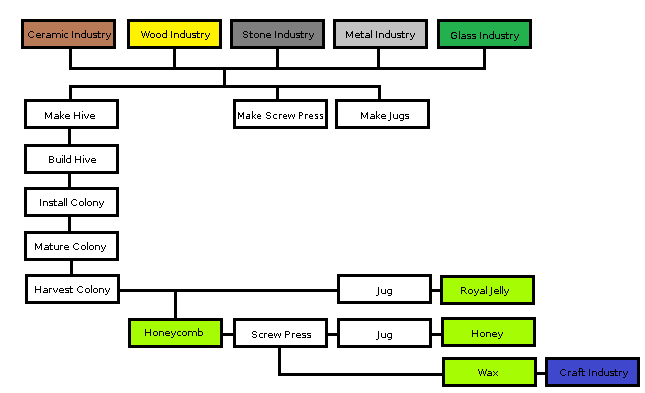- v50 information can now be added to pages in the main namespace. v0.47 information can still be found in the DF2014 namespace. See here for more details on the new versioning policy.
- Use this page to report any issues related to the migration.
v0.34:Beekeeping industry
| This article is about an older version of DF. |
| This feature has one or more outstanding bugs. Please view the Bugs section for details. |
The beekeeping industry is an agricultural process that allows a fortress to produce auxiliary food (honey, royal jelly), drink (mead), and craftable materials (wax) by farming honey bees.
Setup and usage of hives
First up you need an area that can support honey bees (bumblebees can't be used[Verify]). These vermin-type creatures occur in any non-freezing biome. After finding a colony of bees, the next step is to create an artificial hive in the craftsdwarf's workshop, kiln or metalsmith's forge using stone, wood, ceramics or metal.

Construction of the hive is then done by a dwarf with the beekeeping labor enabled, and must be made in a tile adjacent to an above-ground tile. Unless the player specifies otherwise (with q-c), the beekeeper will then automatically find the nearest live hive and transfer it to the artificial hive.
For each empty built hive being set to 'Install colony when ready', an 'Install Colony in Hive' task will be automatically added to the job list. Beekeepers would not take the job unless there is a wild colony of honey bees or ready to split domestic colony in a hive. Multiple beekeepers/hives can task the same colony, see bugs section.
From there the player has two options:
- The player may toggle the hive (using q-g) so that the product is not automatically gathered. This will cause the hive to grow, allowing it to be split into additional hives.
- If the player chooses to have the hive harvested, a beekeeper will approach the hive after 3 months[Verify] or so and transfer royal jelly and honeycomb into empty jugs.
By setting hives to either be harvested, or grown until splittable, a player can enjoy sustainable honey harvesting, even without access to more wild honey bees (for instance, if your fortress is under siege). The hives set to be collected will be periodically destroyed in order to yield honey, and then refreshed by splitting off bees from the non gathering hives.
The royal jelly is counted as an edible item and can be cooked or eaten as is. The honeycomb requires a bit more effort: it must be brought to a screw press to be turned into honey, which is also edible and can be cooked or made into mead. Pressing a honeycomb also requires an empty jug. The honey can be brought to a still and, when combined with a non-absorbent barrel, made into mead.
The pressed honeycomb can be brought to a craftsdwarf's workshop and turned into wax crafts.
Examining hives
Interacting with a hive (q) will show:
- Which options have been set for that hive (install colony or don't, gather products or save for split).
- Whether it has Outdoor access or No outdoor access.
- If the hive is Ready to be split.
If interacting with the hive shows Not ready to be split then it might mean it has a colony too small to be split, or that it has no colony at all. To see if a hive has a colony, uses "view items in buildings" (t), which will show an item stack of thousands of bees if there's a colony. t will also show if the hive has a honey comb or lump of royal jelly.
Artificial hive limits
If your fortress has 41 or more inhabited artificial hives, but less than 60, then interacting with a hive (q) will show:
Presumably this means that existing artificial hives grow more slowly. [Verify]
Having more than 41 or more than 60 inhabited artificial hives does not appear to prevent new wild hives from appearing, and these can still be transferred to empty artificial hives.
If you fortress has 60 or more inhabited artificial hives, then interacting with a hive (q) will show:
Presumably this means that existing artificial hives no longer grow, or that grown hives can't be split. [Verify]
Streamlining production
To create a stockpile that accepts only honeycombs, start with a finished goods stockpile, turn off all types except tools, and all materials except wax.
Bugs
- Dwarves have a hard time splitting hives. They also have a hard time keeping track of wild colonies of bees that die out. Having the beekeeping labor enabled on only one dwarf at a time may alleviate these problems. See Bug:3981 and related bugs.
- Apparently, the problem is caused by multiple empty hives targetting the same colony for installing. The most effective troubleshooting method is to look up the job of a 'stuck' beekeeper in the job list, then zooming to the building - the hive which issued the job. Toggling the 'c' option (install colony) off, letting the game run for a few seconds and then switching the option back on will usually clear the faulty job and issue a new 'install colony in hive' job with a legal target colony.
- Removing and rebuilding empty hives usually fixes beekeepers stuck trying to install colonies, but is much more time-consuming than simply toggling the install option.
- Jugs of royal jelly may be stored in bins as finished goods, preventing its use in the food industry.
- Collecting royal jelly may require more than one jug in storage to begin.
- Screw presses may not allow the "press honeycomb" job to be added directly; adding the job via the manager interface will get the work started.
